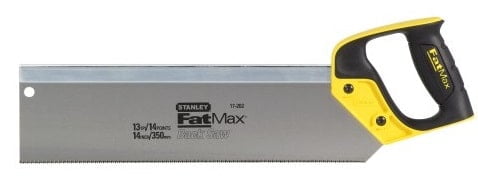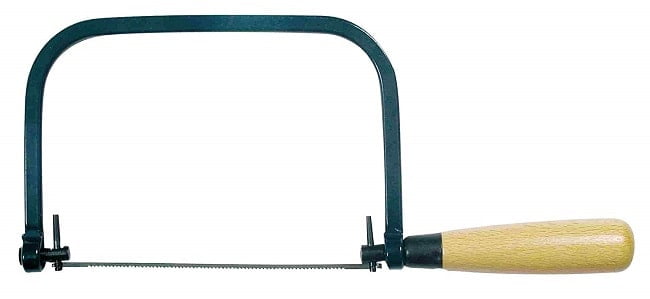Hand saws are pretty awesome tools. There are different types of Hand Saws on the market. These are most of the time lightweight and easy to use. There’s nothing complex about these. Just hold what you want to cut under it and start rubbing. With time, you’ll cut your desired stuff.
The best part about handsaws is they are pretty silent compared to electrical saws. But to use it properly, you have to know about the saw types properly.
Without knowing the types, you might use the wrong saw at the wrong place. As a result, you’ll end up with a ruined cut.
No worries. We’ve got your back.
Here we have brought out 14 types of hand saws and their uses.
So, let’s cut right into the details-
1. Keyhole Saw

As the name suggests, it’s used in making keyholes in wooden doors. It looks like a round handle that has a single blade bulging from the top side of the handle.
Nowadays, it’s mostly used in drywall. When you need to replace a small section from your drywall, then you need to use the keyhole saw. Also, if your wall interior doesn’t allow using power tools, then you have to depend upon keyhole saws.
Our Recommended keyhole Saws:
2. Back Saw

Among the hand saw types, the backsaw is the most popular saw. This one is used for trimming, fine woodcutting, and molding. It’s called the back saw because its upper edge is reinforced with brass or steel. Its teeth are pretty small and grouped tightly. Its blade size can be anywhere in the range between 20 to 40 centimeters.
Check Our Top Pick
3. Crosscut Saw

If you want to rough cut your saws, then this is your thing. This saw has a thick blade compared to other saw blades. Moreover, this saw has large, beveled teeth.
There are 2 men and 1 man crosscut saws available. The 2 men ones are used for cutting timbers. 1 man crosscut saws are used in cutting lumber and trimming limbs.
Check Our Top Pick
No products found.
4. Bow Saw

This is actually another type of crosscut saw. However, this saw is used outside more often. It has a relatively long blade with crosscut teeth. These are widely used for pruning, trimming, and cutting trees and logs. You can use these for rough cuts too.
Check Our Top Pick
No products found.
5. Coping Saw

When you make a list of hand saw types, you can’t ignore the coping saw. This one’s famous for accuracy and intricacy. You can cut a wide range of materials with this saw. However, this saw is available in the toolkits of many professionals.
Read More: How to use coping saw
Check Our Top Pick
No products found.
6. Fret Saw

This one looks a lot like a coping saw. With the long thin blades of an intricate saw, you can make intricate cuts. This saw allows cutting farther from the outer edges thanks to its long and large frame. However, you cannot rotate fret saw blades and as a result, your cutting positions become a lot difficult.
Check Our Top Pick
No products found.
7. Hacksaw
This saw is perfect for-
- Cutting pipes and
- Tubing
However, this is the most versatile handsaw available. You can cut through wood, plastic, metal and other materials with this saw. All you need is just the material-specific blade. You can use cutting blades with a tooth count range of 18 to 32 teeth per inch in this saw.
Check Our Top Pick
8. Japanese Saw
Japanese are famous for their precision and this saw isn’t any different. It’s built with a single handle and a thin but strong cutting blade. It can reach some places where other saws can’t. Dozuki, kataba, and ryoba are the three types of Japanese saws. With these saws, you can cut both hard and softwood with the same precision.
Check Our Top Pick
No products found.
9. Pruning Saw
This saw uses 13 to 15-inch curbed blades. Bulging from a single handle that looks like a pistol grip. Its wide blade can cut in both directions. You’ll find it in the toolkits of homeowners, landscapers, tree surgeons, etc. professionals.
Check Our Top Pick
10. Rip-Cut Saw
When someone saws Saw then the picture of this saw comes to mind at first. Compared to other saws, this saw has fewer teeth per inch. However, each of these teeth is a sharpened point and is designed to cut wood.
It’s common for someone who works with wood to have one or more of these saws.
11. Veneer Saws
Veneer saw is another one of the highly specialized saws. This saw is designed with a short and double-edged blade. Moreover, this blade has around 13 teeth per inch.
Veneer saws are specially used for accurate veneer work. Due to the short blades, it’s really tough to use this for other cutting works.
12. Wallboard Saws
You might get confused between this saw and the keyhole saw. Although these two are pretty similar, there is are differences.
The wallboard saw has shorter and wider blades. Moreover, these blades have fewer teeth per inch and most of the time come with a double edge variety.
It is specially designed for puncturing through drywalls or paneling. Many also use these saws to create starter holes for other power tools.
13. Flooring Saws
When you need to replace floor panels by mid-cutting, then you need to use these saws. Flooring saws are actually pushed stroke hand saws. You’ll find around 12 to 15 teeth per inch in a flooring saw blade.
14. Panel Saws
If you want to cut small pieces of wood, then a panel saw is your best option. When compared to regular hand saws, you’ll find these shorter. Actually, portability is the reason why many people like these.
You can even find panel saws with a length of 46 centimeters. These short saws can have 8 to 12 teeth per inch.
Final Words
Till now we have discussed all the types of hand saws. We believe that now you know when to use what.
Just don’t forget the safety measures while using these saws. Moreover, only buy the best saws from each type if you need to. Or you might not get the best results.
Follow the cutting instructions properly and you’ll have your desired cut in no time. Good luck and happy cutting.
Want to know more about hand saws, check out our complete guides.










